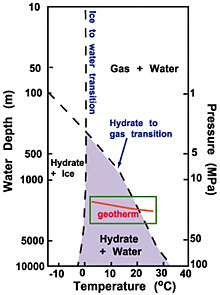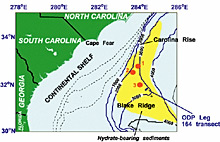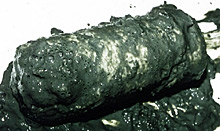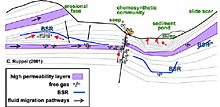
Phase diagram showing the water depths (and pressures) and temperatures for gas hydrate (purple area) stability. Windows to the Deep will explore areas of the Blake Ridge and Carolina Rise in which the uppermost sediments lie within the range denoted by the green box. Click image for larger view and more information.
Gas Hydrates Offshore Southeastern United States
Dr. Carolyn Ruppel
Co-Chief Scientist Associate Professor
Georgia Institute of Technology
Gas hydrate, sometimes known as methane ice, usually forms when methane and water freeze at high pressures and relatively low temperatures. These conditions occur in the shallow part of marine sedimentary sections on many continental margins.
The NOAA Ocean Exploration program has previously studied gas hydrates and associated biological communities in the Gulf of Mexico and on the Southeastern U.S. continental margin. The 2003 Windows to the Deep expedition will again visit the Southeastern U.S. continental margin to explore the ecology, physics, and chemistry of seafloor methane seeps. These seeps provide clues about the underlying gas hydrate reservoir.

Map showing the area where gas hydrates occur (yellow), the location of the 1995 Ocean Drilling Program transect, and the 3 features at which the scientists will conduct Alvin dives. Site 1 is the Cape Fear diapir, and Site 2 denotes the Blake Ridge diapir, which was previously explored during the 2001 NOAA Deep East 3 cruise. Site 3 is the Blake Ridge depression, a region of anomalous seafloor characterized by sediment waves. Click image for larger view and more information.
The 2003 Windows to the Deep expedition will conduct seven Alvin dives on the Blake Ridge and Carolina Rise. These gas hydrate provinces lie several hundred kilometers to the east of the coastlines of South Carolina and Georgia. Gas hydrates here are the result of the great water depths (more than 2,000 meters), the cold sediment temperatures (between 2°C at the seafloor and 25°C at several hundred meters deep in the sediments), and a significant supply of methane. Most of the methane in this area was produced over thousands to millions of years by microbes that degrade organic matter buried with the sediments during deposition. These microbial processes continue today, constantly producing more methane that may eventually become frozen into gas hydrate. Read more about where and how gas hydrate forms in marine sediments ![]() .
.

Concentrated gas hydrate (white material) covered with mud. This core was obtained on the Blake Ridge during Ocean Drilling Program Leg 164.Click image for larger view.
In the Gulf of Mexico and other regions, gas hydrates sometimes occur at or very close to the sea floor and near seafloor mounds. In contrast, on the Blake Ridge and Carolina Rise, the gas hydrate deposits are typically deeply buried in the sediments and rarely breach the sea floor. We saw direct evidence of this in 1995 when sediments to depths of greater than 750 m below the seafloor were drilled during Ocean Drilling Program Leg 164. ![]() It showed that much of the gas hydrate in the area occurs as disseminated, small nodules. Overall, gas hydrate on the Blake Ridge probably only fills a fraction (less than 10 percent) of the available sediment porosity, although higher concentrations can be present in faults and other high permeability zones. Read more about ocean drilling
It showed that much of the gas hydrate in the area occurs as disseminated, small nodules. Overall, gas hydrate on the Blake Ridge probably only fills a fraction (less than 10 percent) of the available sediment porosity, although higher concentrations can be present in faults and other high permeability zones. Read more about ocean drilling ![]() of gas hydrates on the Blake Ridge
of gas hydrates on the Blake Ridge ![]() and the Oregon margin
and the Oregon margin ![]() .
.
Yet, we see exceptions to the rule that gas hydrates occur only deep in the sedimentary section on the Blake Ridge. In some places, deeply buried ancient salt deposits (called diapirs) that are more buoyant than the surrounding sediments have risen toward the sea floor, a process that occurs often in the Gulf of Mexico.
Faults must form to accommodate the deformation caused by with the upward rise of the salt. These faults provide conduits for fluids and gas to migrate through the sediments and sometimes even reach the sea floor. At the same time, the high thermal conductivity of salt leads to significant disturbances of the temperatures in the sediments. For example, instead of temperature increasing by about 0.05°C per meter depth in the sediments, the temperatures of sediments above the top of a shallow salt diapir might increase at 0.1°C per meter depth.
Such temperature changes have a profound impact on the stability of gas hydrate. Specifically, increased temperatures above and near salt diapirs can lead to the development of thin gas hydrate zones that lie close to the sea floor. Essentially, the presence of the shallow diapir compresses the gas hydrate zone toward the sea floor, and the faults associated with the diapir tap into the gas-rich fluids circulating through and from the gas hydrate zone. Sea floor chemosynthetic communities living on and near these faults can gain nourishment from a variety of chemical species carried in the fluids or produced through various processes in the shallow sediments.
Although the Blake Ridge and Carolina Rise lack high overall concentrations of gas hydrate, the total amount of trapped gas is significant on a global scale. Furthermore, these areas will help us advance our understanding of the dynamics of gas hydrate reservoirs. One advantage of the area is the relatively homogeneous composition of the sediments. Another advantage is that the Blake Ridge and Carolina Rise have almost exclusively methane gas hydrates. This contrasts with the oil-producing Gulf of Mexico basin, where many other hydrocarbons that can form gas hydrate occur. Thus, studying hydrates in this setting allows scientists to better understand the fundamental links among physics, chemistry, and biology in gas hydrate provinces.





















